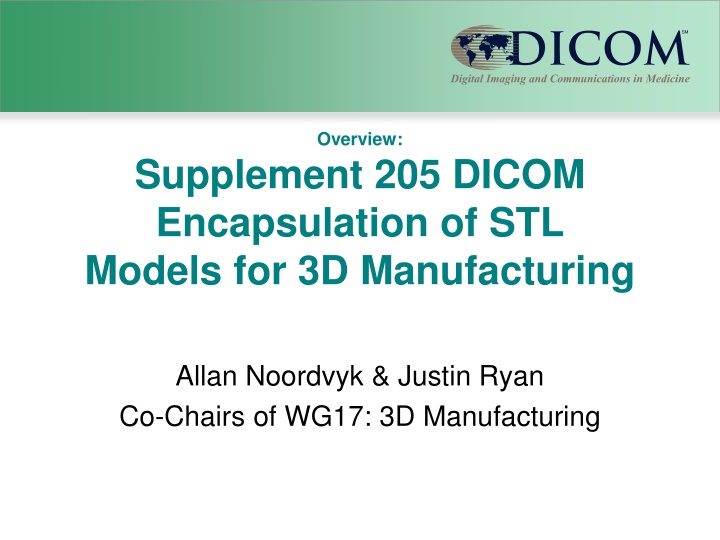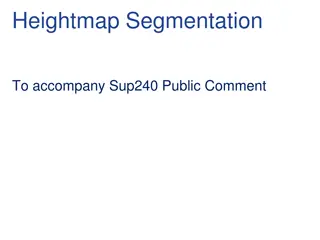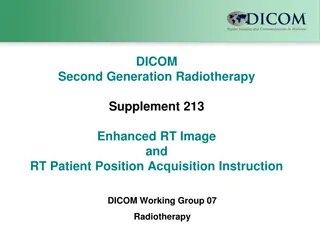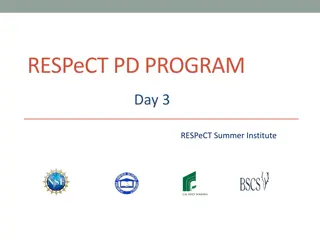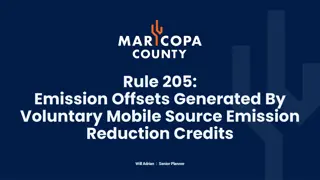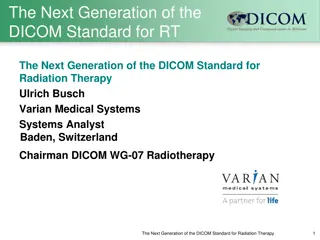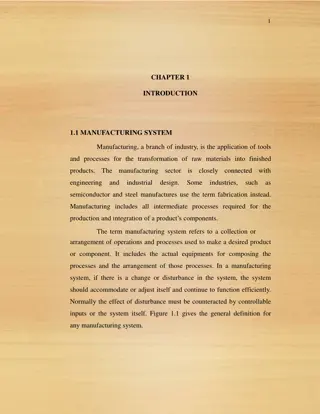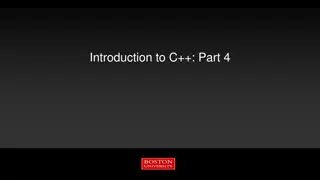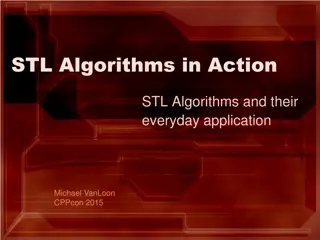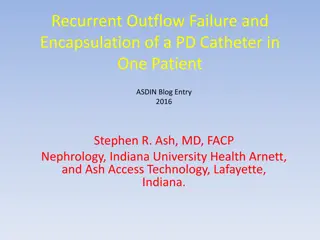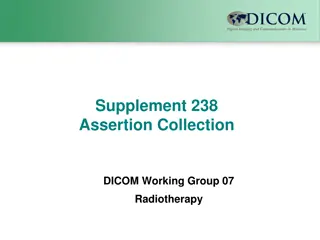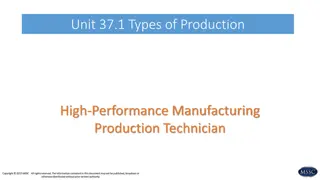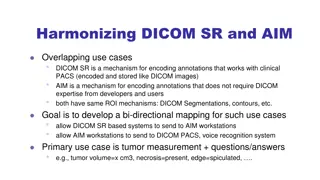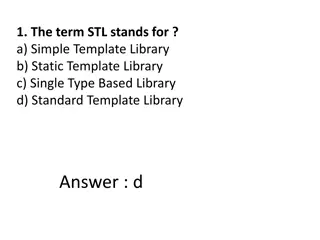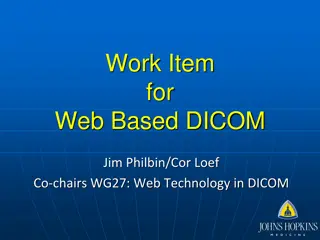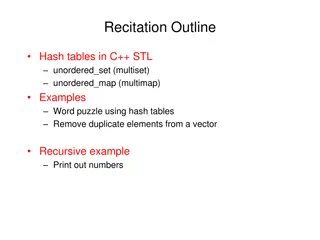Supplement 205: DICOM Encapsulation of STL Models for 3D Manufacturing
This supplement delves into the encapsulation of STL models within the DICOM format for 3D manufacturing processes. It explores the background, main components, and challenges faced by Working Group 17. The mandate, format challenge, main components of the supplement, and new objects and modules introduced are discussed in detail.
Download Presentation

Please find below an Image/Link to download the presentation.
The content on the website is provided AS IS for your information and personal use only. It may not be sold, licensed, or shared on other websites without obtaining consent from the author.If you encounter any issues during the download, it is possible that the publisher has removed the file from their server.
You are allowed to download the files provided on this website for personal or commercial use, subject to the condition that they are used lawfully. All files are the property of their respective owners.
The content on the website is provided AS IS for your information and personal use only. It may not be sold, licensed, or shared on other websites without obtaining consent from the author.
E N D
Presentation Transcript
Overview: Supplement 205 DICOM Encapsulation of STL Models for 3D Manufacturing Allan Noordvyk & Justin Ryan Co-Chairs of WG17: 3D Manufacturing
Contents Background Main Components Expected Use Specific Changes Working Group 17 3D Manufacturing 2
Background Working Group 17 3D Manufacturing 3
WG17 Mandate Working Group 17 mandate Allow store/query/retrieve 3D models, intended for 3D manufacturing, as DICOM objects Addressed by Work Item 1 Leverage a) Existing and growing ecosystem of DICOM- capable systems in use in healthcare institutions and b) Standards and conventions already in use in the 3D printing industry Working Group 17 3D Manufacturing 4
Format Challenge ISSUE: There are numerous standards- based file formats in current use within the medical 3D printing community The working group decided to initially focus on the most ubiquitous, simplest format: STL We expect to address other formats with their unique capabilities in future Working Group 17 3D Manufacturing 5
Main Components of Supplement Working Group 17 3D Manufacturing 6
This Supplement The first output of work item 1 is Supplement 205: DICOM Encapsulation of STL Models for 3D Manufacturing Adapts encapsulation approach used for other documents Working Group 17 3D Manufacturing 7
New Object / SOP New Information Object Definition (IOD): Encapsulated native STL file for Creation, Review, Update, and Printing (manufacturing) New Service Object Pair (SOP): Encapsulated STL Storage Working Group 17 3D Manufacturing 8
New Module New Manufacturing 3D Model Module Addresses medical 3D model information not present in either current DICOM or STL model data formats Contains a mix of newly defined and pre- existing attributes not present in Encapsulated Document module We expect this module will be used in future additional 3D manufacturing related IODs Working Group 17 3D Manufacturing 9
Expected Use Working Group 17 3D Manufacturing 10
Expected Use The new IOD/SOP is expected to address these real world use cases: Creation Review Update Print Working Group 17 3D Manufacturing 11
Expected Use (continued) Use Case 1: Creation Medical reconstruction software queries Image manger system User creates patient-specific 3D model (reconstruction and modeling) Modeler system creates the new type DICOM object containing the 3D model, populating all required metadata User saves 3D model back to the patient s record in DICOM format as either (a) an addition to an existing study or (b) a new study The Modeler system stores the new DICOM object in the Image Manager system PACS/VNA PACS/VNA Working Group 17 3D Manufacturing 12
Expected Use (continued) Use Case 2: Review PACS/VNA At a later time to Use Case 1, a user indicates desire to visually review a 3D model , prior to 3D printing Display System The Display system queries the Image Manager for the DICOM objects of new type The Display system retrieves the indicated object The Display system extracts the 3D model from the object and displays it to the user, potentially registered for simultaneous display with source images Working Group 17 3D Manufacturing 13
Expected Use (continued) Use Case 3: Update PACS/VNA At a later time to Use Case 1, a user indicates desire to modify a 3D model for a particular patient The Modeler system queries the Image Manager for the DICOM objects of new type If necessary, the Modeler system retrieves any source images (s1 to sN) required for this modification to occur User interacts with the Modeler system to adjust the 3D printable model as desired Working Group 17 3D Manufacturing 14
Expected Use (continued) Use Case 3: Update (cont d) User saves back to the patient s record in DICOM format as either (a) an addition to an existing study, or (b) a new study The Modeler system creates the new type DICOM object containing the new version 3D model, populating all required metadata and including a unique identifier reference to the supplanted earlier 3D print model object The Modeler system stores the new DICOM object in the Image Manager system PACS/VNA Working Group 17 3D Manufacturing 15
Expected Use (continued) Use Case 4: Print PACS/VNA At a later time to Use Case 1, a user indicates desire to print a 3D model for a particular patient Print Manager The Print Manager system queries the Image Manager for the DICOM objects of new type belonging to the patient The Print Manager system retrieves the indicated 3D print model object The Print Manager access the 3D model information within the object, using this to create non-DICOM print instructions for a specific 3d printer (e.g. .stl) Working Group 17 3D Manufacturing 16
Expected Use (continued) Use Case 4: Print (cont d) Print Manager The Print Manager prompts the user for any necessary additional print parameters (e.g. support, bed placement, material parameters, etc.) The Print Manager submits the print job to the printer Optionally, the Print Manager may save an updated 3d print object back to the Image Manager in order to preserve exact print parameters used (per Use Case 3, steps 7+). PACS/VNA Working Group 17 3D Manufacturing 17
Specific Changes to Standard Working Group 17 3D Manufacturing 18
Payload Builds on approach used for encapsulation other file formats (PDF, CDA) STL file encoded via Encapsulated Document (0042,0011) attribute Registration of new MIME type model/stl completed with IANA (March 6, 2018) More compact binary variant only supported no ASCII Working Group 17 3D Manufacturing 19
Source Images Reference References to images from which the model is derived (if known) Allows users to review models vs. patient anatomy for accuracy/relevance prior to printing Addressed through Source Instance (0042,0013) attribute With frame of reference / registration addressed per standard Working Group 17 3D Manufacturing 20
Predecessor Instances Optionally reference objects representing prior models, on which new model is based Including classifying nature of the changes Supports workflows around successive refinement editing Uses Predecessor Documents Sequence (0040,A360) attribute Working Group 17 3D Manufacturing 21
PHI Management 3D printing introduces some new wrinkles to protecting patient s privacy Clarified use of existing attributes when applied to 3D models Burned In Annotation (0028,0301) Recognizable Visual Features (0028,0302) Working Group 17 3D Manufacturing 22
Disambiguated Scale ISSUE: STL files have no inherent scale Relying on humans to guess scale the creator intended is a patient safety issue Addressed via Mandatory Measurement Units Code Sequence (0040,08EA) used to specify at time of creation Uses codes from new Model Scale Units CID Allowed Values: m cm mm um In New Manufacturing 3D Model Module Working Group 17 3D Manufacturing 23
Modified Anatomy Indication ISSUE: Some models represent patient current anatomy, while others project results of interventions Risk of confusion Enumerated Values: Yes No New Attribute: Model Modification Specifies whether modification (beyond mirroring) was used to create the model Specifies whether the object represents the observed patient anatomy in the source data Optional since may not always be known In New Manufacturing 3D Model Module Working Group 17 3D Manufacturing 24
Mirroring Indication ISSUE: Some models leverage bilateral symmetry to simulate absent or damaged anatomy Risk of confusion Enumerated Values: Yes No New Attribute: Model Mirroring Specifies whether mirroring of anatomy from the other side of the patient was used to create the model Optional since may not always be known In New Manufacturing 3D Model Module Working Group 17 3D Manufacturing 25
Model Usage ISSUE: The intended use of a model may not always be clear from appearance Risk of confusion Defined Terms: Educational Intent Diagnostic Intent Planning Intent Tool Fabrication Prosthetic Fabrication Implant Fabrication Quality Control Intent Simulation Intent New Attribute: Model Usage Code Sequence Specifies the use for which the manufactured object is initially intended using new CID In New Manufacturing 3D Model Module Working Group 17 3D Manufacturing 26
Model Usage Values Intended for educational purposes. For example: patient or care-giver education/informed consent, or training residents and fellows. Previously defined. SRT R-408C3 Intended to be used to assist with procedure planning. Intended to be used to manufacture a patient-matched tool that is employed during a medical procedure. For example: drill/cutting guides, immobilizers, radiation shields, and plate bending templates. Intended to be used to manufacture a fully external prosthetic/orthotic. Intended to be used to manufacture a wholly or partially internal implant. Previously defined. DCM 113680 Intended to be used for simulation and/or practice of a surgery or other medical procedure. Simulation is not used for patient-matched simulation, as this would be covered by Diagnostic Intent or Planning Intent . Educational Intent Diagnostic Intent Planning Intent Tool Fabrication Prosthetic Fabrication Implant Fabrication Quality Control Intent Simulation Intent Working Group 17 3D Manufacturing 27
Preview Image ISSUE: Visual selection helpful when multiple different models in same study Optionally include 2D preview image representation Avoids need to load, parse, and render the model just for a quick preview Uses Icon Image Sequence (0088,0200) Working Group 17 3D Manufacturing 28
Derivation Algorithm ISSUE: Users may wish to known which modeling software algorithm was used to produce a particular model Optionally record the algorithm used to perform the derivation Uses Derivation Algorithm Sequence (0022,1612) attribute Working Group 17 3D Manufacturing 29
